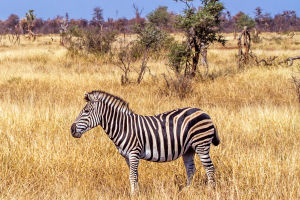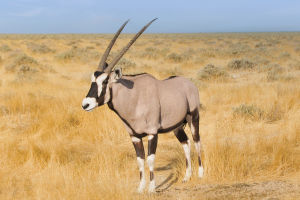Antelopes are light and graceful animals that are widely distributed in grasslands, deserts, and forests in Africa and Asia.
They come in many species and sizes, adapted to different environments.
Antelopes are agile, especially when they run, showing a perfect combination of natural elegance and speed.
Their long horns are one of the most obvious features, which not only makes them stand out on the grassland but also serves as an important tool for defense against predators.
Antelopes mostly live in groups, which not only increases the efficiency of foraging but also helps to avoid the threat of predators. When the antelopes feel danger, they will suddenly run collectively, and this collective behavior makes it more difficult for predators to lock on to their targets.
They run very fast, and some antelope species can even reach more than 80 kilometers per hour. This speed not only helps them quickly escape from predators but also allows them to move quickly across the vast grasslands to find water and food.
Antelopes mainly eat grasses and leaves, and their digestive systems are well suited to processing these rough plants. Because they live in arid areas, antelopes can often go for a long time without drinking water and absorb water from food. This allows them to survive in extreme conditions without having to search for water frequently.
Different species of antelope have unique survival strategies and adaptations. For example, smaller species often rely on hiding and quick reactions to avoid predators, while larger species rely more on the protection of the group and their strength to resist threats.
In addition, some antelope species have developed seasonal migration behaviors. They move long distances between the rainy and dry seasons to find a more suitable living environment.
The breeding season for antelopes usually takes place when the rainy season arrives, because the grasslands are plentiful with food and water. Female antelopes usually choose secluded places to give birth to their calves and protect them very carefully in the first few months after the calves are born.
Antelope calves can stand up and follow their mothers shortly after birth. This rapid growth is crucial to their survival because they need to be able to run as early as possible to escape predators.
Although antelopes have shown strong survival capabilities in nature, they still face serious threats from human activities. Habitat destruction, overhunting, and climate change are all affecting the survival of antelopes.
Many antelope populations are declining, especially in some severely damaged areas, and some antelope species are even on the verge of extinction.
To protect antelopes, humans have taken some measures, such as establishing protected areas, banning hunting, and carrying out breeding programs for endangered species.
Although these measures have alleviated the decline in antelope numbers to a certain extent, there is still a long way to go. Protecting antelopes is not just about protecting an animal, but also protecting the ecosystems they depend on.
Antelopes are also important symbols in many cultures. In some tribal cultures in Africa, antelopes represent speed, elegance, and agility and are regarded as spirits of nature. Their images also often appear in works of art and literature, symbolizing the embodiment of freedom and vitality in nature.
Antelopes are one of the most graceful and flexible animals on earth. They thrive in harsh environments through their own unique way of survival, showing the resilience and beauty of life.
Today, as humans continue to change the natural environment, protecting animals like antelopes is not only a respect for nature but also a protection for our future.


